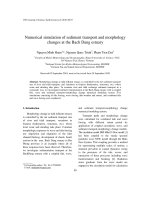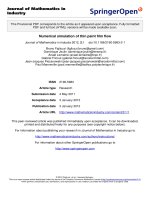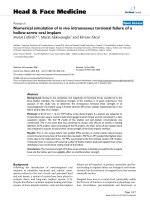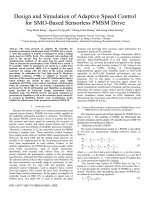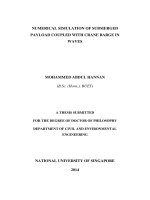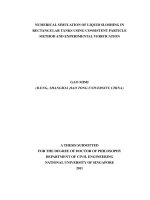Numerical simulation of supercavitation
Bạn đang xem bản rút gọn của tài liệu. Xem và tải ngay bản đầy đủ của tài liệu tại đây (8.03 MB, 113 trang )
NUMERICAL SIMULATION OF
SUPERCAVITATION
ZENG HUIMING
(B.S., M.E., HUST)
A THESIS SUBMITTED
FOR THE DEGREE OF MASTER OF ENGINEERING
DEPARTMENT OF MECHANICAL ENGINEERING
NATIONAL UNIVERSITY OF SINGAPORE
2007
Acknowledgements
I would like to express my deepest and most sincere gratitude to Professor Khoo Boo
Cheong for all the continuous support, invaluable encouragement, and academic guidance
provided as the thesis supervisor in the last two years, as well as his comprehensive
instruction and assistance during my thesis writing. My gratitude also goes to the
co-supervisor Dr. Liu Tiegang for his support, instruction and expertise which greatly
help me during my studies in numerical techniques for supercavitating flow. Furthermore,
I would give my greatest appreciation to him for providing the basic programme codes
and valuable advice throughout the whole study. Also, I would sincerely appreciate the
help of Dr. Xie Wenfeng, my friends in the Fluid Lab and my two roommates.
My entire family deserves a special gratitude for their unlimited support during my
oversea study. It is their constant love and encouragement that make the completion of
this work possible.
At last, I would like to thank the National University of Singapore for their Research
Scholarship.
Zeng Huiming
Jul, 2007
i
Table of Contents
Acknowledgements .............................................................................. i
Table of Contents ................................................................................ ii
Summary ..............................................................................................v
List of Tables ..................................................................................... vii
List of Figures................................................................................... viii
Nomenclature ................................................................................... xiv
Chapter 1 Introduction………………………………………...……1
1.1 Background………………………………………………………..……...1
1.2 Literature Review of Difficulties in Numerical Simulations of Cavitating
Flow…………………………………………………………...…………2
1.3 Literature Review of Experiments and Numerical Simulations of
Supercavitation…………………………………………………………5
1.4 Motivation of the Research on the Numerical Simulation of
Supercavitation…………………………………………………………..7
1.5 Outline of Thesis……………………………..…………………………...9
Chapter 2 Methodologies……………………………………..……10
2.1 Governing Equations………………………………………….....………10
2.2 Equation of State for Gas and Water………………………………….....12
ii
2.3 The Eulerian Solver……………………………………………………...13
2.4 The Level Set Technique and its application to Structure Interface…….17
2.5 The Modified Ghost Fluid Method……………………………….……..21
Chapter 3 Cavitation Models………………………………..…….22
3.1 Assumptions for the simulation…..………………………………….….23
3.2 Relationship across the Cavitation Boundary……………………….….24
3.3 Cavitation Models………………………………………………….…...25
3.3.1 Cut-off Model…………………………………………………….……...25
3.3.2 Isentropic Model……………………………………………….………..26
3.4 The One-fluid Cavitation Models for Multi-dimensions………………..28
3.5 Verification of Isentropic One-fluid Cavitation Model…………..……...29
3.5.1 Verification of Cavitation Models by 2D flow passing over a forward
facing step…………………………………………..…………………...30
Chapter 4 Special Treatment for the Corner Point at a Forward
Facing Step…………………………………………………...……33
4.1 the Mesh Refinement for Multiphase Flow………..……………….……33
4.2 The Special Treatments of Corner………………………………….……36
4.2.1 The Entropy and Enthalpy Corrections for Single Phase (gas) Flow…....38
4.2.2 Restriction of Pressure at the corner for water flow………………..…....41
4.3 Concluding Remarks of the Chapter…………………………………....44
iii
Chapter 5 Numerical Simulations of Supercavitation inception
and evolution over a high-speed Projectile…...……...46
5.1 Numerical Simulation of Supercavitation Flow over a Forward-facing
Step………………………………………………………………….…..47
5.2 Numerical Simulation of Flow over a Hemisphere head Projectile……..50
5.3 Concluding Remarks of the Chapter…………………………………….53
Chapter 6 Conclusion and Future Work……………………...…..55
References………………………………………..…………………57
Tables……………………………………………………..………....62
Figures……………………………………………………..………..63
iv
Summary
In this work, the research is focused on simulating the cavitating flow and supercavitating
flow. Based on the previous theoretical analysis on existing two one-fluid cavitation
models and numerical tests, the isentropic model is proved to be more consistent and
physically realistic than the cut-off cavitation model. In addition, to further verify the
isentropic model, cavitating flow occurring in two-dimensional cavitating flow is
simulated.
To study the supercavitating flow over high speed projectiles, two different
underwater projectile models are simulated, one is a forward-facing step, and the other is
a hemisphere head projectile.
In the simulation of flow over a forward-facing step, the corner point is a singular
point. Based on the fixed Eulerian grids, if no special treatment is applied on the singular
point, an unphysical expansion shock will emanate from the corner. In the work, two
special corrections are employed to treat the corner, which are entropy and enthalpy
corrections and the restriction of pressure at the corner point. It is found that the entropy
and enthalpy correction, which works well for single phase flow, does not work for water
flow with phase transition (cavitation). From the experimental results, the flow always
starts to cavitate at the corner point: by restricting the pressure of the corner point to the
saturated pressure whenever there is phase change at the corner, the unphysical expansion
shock can be efficiently removed for the multi-phase flow.
In the simulation of flow over a hemisphere head projectile, the reflective boundary
v
condition is employed to treat the rigid boundaries. However, the coding for treatment of
a rigid boundary of complex geometry is usually quite complex. To develop a consistent
way of rigid boundary treatment, the level set technique is extended to treat the rigid
boundary together with the reflective boundary condition.
Numerical simulation of supercavitaton has been carried out for these two
underwater projectiles by employing MUSCL scheme and the isentropic cavitation model.
Furthermore, the process of cavitation inception, evolution over a high speed underwater
projectile is investigated. The captured cavitation pocket and pressure distribution along
the projectile surface are also investigated. It is shown that the simulation results are
reasonable and physical comparing with the experimental data (Rouse & McNown 1948).
vi
List of Tables
Table 4-1
Error pertaining to grid refinement
62
vii
List of Figures
Fig. 2-1
Construction of Point A and B in extrapolation
63
Fig. 3-1
Convergence contour with computing loops using the cut-off
cavitation model
64
Fig. 3-2a
Contour plots of numerical approximation of the pressure with
MUSCL scheme with cut-off cavitation model at t= 4.13E-04s
64
Fig. 3-2b
Contour plots of numerical approximation of the density with
MUSCL scheme with cut-off cavitation model at t= 4.13E-04s
65
Fig. 3-2c
Contour plots of numerical approximation of the pressure with
MUSCL scheme with cut-off cavitation model at t= 8.24E-04s
65
Fig. 3-2d
Contour plots of numerical approximation of the density with
MUSCL scheme with cut-off cavitation model at t= 8.24E-04s
66
Fig. 3-3
Convergence contour with computing loops using the Isentropic
cavitation model
66
Fig. 3-4a
Contour plots of numerical approximation of the pressure with
MUSCL scheme with meshes [301, 101] at t= 8.20E-04s
67
Fig. 3-4b
Contour plots of numerical approximation of the density with
MUSCL scheme with meshes [301, 101] at t= 8.20E-04s
67
Fig. 4-1
The mesh distribution for Case 4.1.1, Case 4.2.1.1, Case 4.2.2.1
and Case 4.2.2.2 in the vicinity of the cylinder surface
68
Fig. 4-2a
Contour plots of Experimental result of the density by Rouse and
McNown(1948) at the velocity of 25.3m/s and pressure of 1atm
68
Fig. 4-2b
Contour plots of Experimental result of pressure distribution along
the projectile surface at different cavitation number by Rouse and
McNown (1948)
69
Fig. 4-3a
Contour plots of numerical approximation of the pressure with
MUSCL scheme with meshes [301, 101] at t= 8.20E-04s
69
viii
Fig. 4-3b
Contour plots of enlarged section on the pressure distribution near
the corner with MUSCL scheme with meshes [301, 101] at t=
8.20E-04s
70
Fig. 4-3c
Contour plots of numerical approximation of the density with
MUSCL scheme with meshes [301, 101] at t= 8.20E-04s
70
Fig. 4-3d
Contour plots of pressure distribution along the projectile surface
with MUSCL scheme with meshes [301, 101] at t= 8.20E-04s
71
Fig. 4-4a
Contour plots of numerical approximation of the pressure with
MUSCL scheme with meshes [601, 201] at t= 1.78E-03s
71
Fig. 4-4b
Contour plots of enlarged section on the pressure distribution near
the corner with MUSCL scheme with meshes [601, 201] at t=
1.78E-03s
72
Fig. 4-4c
Contour plots of numerical approximation of the density with
MUSCL scheme with meshes [601, 201] at t= 1.78E-03s
72
Fig. 4-4d
Contour plots of pressure distribution along the projectile surface
with MUSCL scheme with meshes [601, 201] at t= 1.78E-03s
73
Fig. 4-5a
Cell locations where Entropy and Enthalpy corrections are applied
for the forward facing step test at Mach 3 flow
73
Fig. 4-5b
Initial Diagram of Mach 3 flow
74
Fig. 4-6a
Contour plots of numerical approximation of the pressure without
fixing at t= 1.61E-04s
74
Fig. 4-6b
Contour plots of numerical approximation of the density without
fixing at t= 1.61E-04s
75
Fig. 4-6c
Contour plots of numerical approximation of the pressure with
MUSCL scheme using entropy and enthalpy corrections at t=
1.88E-04s
75
Fig. 4-6d
Contour plots of numerical approximation of the density with
MUSCL scheme using entropy and enthalpy corrections at t=
1.88E-04s
76
Fig. 4-6e
Contour plots of numerical approximation of the pressure with
76
ix
MUSCL scheme using entropy and enthalpy corrections at t=
3.40E-04s
Fig. 4-6f
Contour plots of numerical approximation of the density with
MUSCL scheme using entropy and enthalpy corrections at t=
3.40E-04s
77
Fig. 4-7a
Contour plots of numerical approximation of the pressure with
MUSCL scheme with meshes [301, 101] at t= 1.36E-03s
77
Fig. 4-7b
Contour plots of numerical approximation of the density with
MUSCL scheme with meshes [301, 101] at t= 1.36E-03s
78
Fig. 4-7c
Pressure Distribution along the projectile surface with MUSCL
scheme with meshes [301, 101] at t= 1.36E-03s
78
Fig. 4-8a
Contour plots of the pressure without fixing at the corner point at t=
6.23E-04s
79
Fig. 4-8b
Contour plots of the density without fixing at the corner point at t=
6.23E-04s
79
Fig. 4-8c
Contour plots of numerical approximation of the pressure with
MUSCL scheme with the restriction of pressure fix at the corner
point at t= 6.20E-04s
80
Fig. 4-8d
Contour plots of numerical approximation of the density with
MUSCL scheme with the restriction of pressure fix at the corner
point at t= 6.20E-04s
80
Fig. 4-8e
Pressure Distribution along the projectile surface with MUSCL
scheme with the restriction of pressure fix at the corner point at t=
6.20E-04s
81
Fig. 5-1a
Contour plots of numerical approximation of the pressure with
MUSCL scheme with the restriction of pressure fix at the corner
point at t= 1.24E-03s
82
Fig. 5-1b
Contour plots of numerical approximation of the density with
MUSCL scheme with the restriction of pressure fix at the corner
point at t= 1.24E-03s
82
Fig. 5-1c
The Pressure distribution along the projectile surface for Case 5.1.1
83
x
at t= 1.24E-03s
Fig. 5-2a
Mean Cavitaion Pockets for blunt head projectile at different
cavitation number by Rouse & McNown (1948)
83
Fig. 5-2b
Contour plots of Experimental result of pressure distribution along
the projectile surface at different cavitation number by Rouse and
McNown (1948)
84
Fig. 5-3a
Contour plots of numerical approximation of the pressure with
MUSCL scheme with the restriction of pressure fix at the corner
point at t= 2.98E-04s
84
Fig. 5-3b
Contour plots of numerical approximation of the density with
MUSCL scheme with the restriction of pressure fix at the corner
point at t= 2.98E-04s
85
Fig. 5-3c
Contour plots of numerical approximation of the pressure with
MUSCL scheme with the restriction of pressure fix at the corner
point at t= 5.98E-04s
85
Fig. 5-3d
Contour plots of numerical approximation of the density with
MUSCL scheme with the restriction of pressure fix at the corner
point at t= 5.98E-04s
86
Fig. 5-3e
Contour plots of numerical approximation of the pressure with
MUSCL scheme with the restriction of pressure fix at the corner
point at t= 1.19E-03s
86
Fig. 5-3f
Contour plots of numerical approximation of the density with
MUSCL scheme with the restriction of pressure fix at the corner
point at t= 1.19E-03s
87
Fig. 5-4
Schematic of the computational domain of a hemisphere head
projectile
87
Fig. 5-5a
Contour plots of numerical approximation of the density of gas at
t= 3.06E-04s
88
Fig. 5-5b
Contour plots of numerical approximation of the density of gas at
t= 5.09E-04s
88
Fig. 5-5c
Contour plots of numerical approximation of the density of gas at
88
xi
t= 1.02E-03s
Fig. 5-5d
Contour plots of numerical approximation of the density of gas at
t= 2.03E-03s
89
Fig. 5-6a
Contour plots of numerical approximation of the x velocity of gas
at t= 2.04E-02s
89
Fig. 5-6b
Contour plots of numerical approximation of the y velocity of gas
at t= 2.04E-02s
89
Fig. 5-6c
Contour plots of numerical approximation of the pressure of gas at
t= 2.04E-02s
90
Fig. 5-6d
Contour plots of numerical approximation of the density of gas at
t= 2.04E-02s
90
Fig. 5-7a
Contour plots of numerical approximation of the pressure of water
at t= 2.13E-04s
90
Fig. 5-7b
Contour plots of numerical approximation of the density of water at
t= 2.13E-04s
91
Fig. 5-7c
Contour plots of numerical approximation of the pressure of water
at t= 3.36E-04s
91
Fig. 5-7d
Contour plots of numerical approximation of the density of water at
t= 3.36E-04s
91
Fig. 5-7e
Contour plots of numerical approximation of the pressure of water
at t=6.73E-04s
92
Fig. 5-7f
Contour plots of numerical approximation of the density of water at
t=6.73E-04s
92
Fig. 5-7g
Contour plots of numerical approximation of the pressure of water
at t= 1.42E-03s
92
Fig. 5-7h
Contour plots of numerical approximation of the density of water at
t= 1.42E-03s
93
Fig. 5-8a
Contour plots of numerical approximation of the x velocity of
water at t= 2.85E-03s
93
xii
Fig. 5-8b
Contour plots of numerical approximation of the y velocity of
water at t= 2.85E-03s
93
Fig. 5-8c
Contour plots of numerical approximation of the pressure of water
at t= 2.85E-03s
94
Fig. 5-8d
Contour plots of numerical approximation of the density of water at
t= 2.85E-03s
94
xiii
Nomenclature
It is not practical to list all the symbols that have been used. Below the author list the
more important ones. Some of the symbols are defined as they are used.
English alphabets
a
a
Speed of sound
Speed of sound in liquid
A
Constant in JWL equation
B
Constant in Tait’s Equation;
Constant in JWL equation
c
Speed of sound for gas, water or solid
CFL
CFL number
d
Derivative operator
e
Internal energy per unit volume
E
Total flow energy
F
Inviscid flow flux in the x or radial (r) direction
G
Inviscid flow flux in the y or z direction
H
Inviscid Flux;
Enthalpy
i
Grid point in x direction
I
A column vector
xiv
j
Grid point in y direction
k
Grid point in z direction;
A model constant in the Isentropic model
n
The constant of source term for Euler equations
N
Unit normal
r
N
Unit normal vector
p
Flow pressure
p
p+B
r
radial coordinate
r
r
The trajectory
s
The speed of moving interface
S
Source term in the 2D symmetric Euler equation;
Specific entropy
t
Time interval
T
Temperature
u
Flow velocity component in the x or radial direction
U
Conservative variable vector in the Cartesian system
v
Flow velocity component in the y direction
x
x coordinate
y
y coordinate
z
z coordinate
xv
Greek alphabets
α
Void fraction;
Nonnegative parameter
γ
specific heat Ratio of for gas
EOS constants for water and solid
ρ
Flow density
ω
Constant in JWL equation
φ
Flow composition;
Level set function
Δt
Time step size
Δx
Spatial step size
λ
Δt Δx ;
Eigenvalue
Superscripts
a
The cell “a”
b
The cell “b”
cav
cavitation
I
Index of interface
l, L
n
Left
Temporal index
xvi
R
'
Right
A reference status
Subscripts
0
Index of initial flow status
a
Flow status under atmosphere pressure
A, B, C , D
End cell boundaries
cav
Cavitation
g
index of Gas
i
Index of a grid in x direction
j
Index of a grid in y direction
l
Index of the fluid flow in the left side of the interface;
Index of liquid
L
Left side
m
Index of mixture medium
n
Temporal index
N
Index of normal direction
R
Right side
sat
Index of saturated status
t
Time
x
x coordinate
y
y coordinate
xvii
xviii
Chapter 1
Introduction
1.1 Background
Cavitation is formation of pockets of vapor. It happens when water is forced to move at
high speed. Given sufficient speed and a suitable shape of an object, the (intended)
cavitation can extend as a single large bubble of water vapour, even enveloping the entire
object. The intended cavitation is called supercavitation.
When supercavitation occurs on an underwater object, the hydrodynamic drag
imposed on the surface of the object is significantly reduced as the wetted surface of the
object is practically only located at the tip of the object where the water is in directly
contact with the object, and the drag in vapor is normally about 100 times less than that in
water. Therefore, the object is able to travel much faster inside water with the same
amount of energy spent to propel the object forward compared to that when the
supercavitation does not appear. Because supercavitation can largely reduce the drag of
underwater object, its main application is on underwater projectiles. In recent years, more
and more people are interested in the research of supercavitation.
The text below is arranged as follows. Section 1.2 introduces the literature review of
difficulties in numerical simulations of cavitating flow. The literature review of
experiments and numerical simulations of supercavitation is presented in section 1.3. The
motivation of this work is presented in section 1.4. Lastly, the outline of this thesis is
shown in section 1.5.
1
1.2 Literature Review of Difficulties in Numerical Simulations of Cavitating
Flow
From the viewpoint of numerical simulation of cavitating flow, there are two major
difficulties encountered. One is the stable numerical algorithm. The other is the
application of appropriate cavitation model to simulate the phase change. Due to the
appearance of cavitation, flow phase transition occurs and a dynamic moving interface is
formed to separate the pure liquid phase and cavitating flow.
It is not easy to track the dynamic boundary of cavitating flow because of the
creation and collapse of cavitation. Numerical oscillations are inevitably encountered to
capture the moving interfaces when one applies a well-established numerical solver valid
for single phase flow directly to the multiphase flow. These oscillations will not occur in
the single phase flow (Karni, 1994). Additional techniques are usually required to
suppress such oscillations. Karni (1994) used small viscous perturbations to completely
eliminate the oscillations. Abgrall (1996) suppressed the pressure oscillation by
modifying the finite volume scheme. A quasi-conservative formulation of compressible
Euler equations is applied to remove the oscillations by Shyue (1998). Recently, the
Ghost Fluid Method (GFM) was developed to reduce the oscillations (Fedkiw et al, 1999;
Liu et al, 2003b).
Among those techniques mentioned above, the Ghost Fluid Method (Fedkiw et al,
1999; Fedkiw, 2002) provided a flexible way to treat the moving material interfaces. One
main advantage is that a GFM based method can be easily extended to multi-dimensions
by updating the flow field across the interface of different mediums. However, the
2
original GFM (Fedkiw et al, 1999; Fedkiw, 2002) was found to provide inaccurate results
or even fail to work when applied to strong shock or stream jet impacting on a material
interface. To overcome this difficulty, Liu et al (2003b) modified the original GFM,
leading to the development of the modified Ghost Fluid Method (MGFM), which is more
appropriate for strong shock problems. Subsequently, the MGFM is further shown to be
robust and efficient when applied to treat gas-gas, gas-liquid and fluid structure interface
(Liu et al, 2003b; Liu et al, 2005; Liu et al, 2006).
There are two main ways to simulate the cavitating flow. One is cavitation interface
tracking method and the other is the continuum modelling method. Assuming that there is
a clear and distinct interface between the liquid and the vapor, the interface tracking
method determines the cavitation interface location via an iterative procedure (Deshpande
et al, 1994). This method is only applicable for attached and well-shaped cavitation. The
reason is that the cavitation interface is treated as a stream line in that method. On the
other hand, the continuum method assumes that there are continuous variations between
the liquid and vapour extremes which is often called two-phase model. Ahuja et al (2001)
and Kubota et al (1992) applied two-phase models to simulate the cavitating flow. In
addition, Kunz et al (2000) predicted the cavitation by solving Navier-Stokes equation
with a two-phase model. Also, Senocak and Shyy (2002) used that two-phase model to
simulate turbulent cavitating flow.
Two-phase models can be further divided in two categories by different approaches.
One is called the two-fluid model and the other is the one-fluid model. Two-fluid assumes
that liquid phase and vapour phase co-exist at every point in the flow field. Furthermore,
3
each phase is governed by its own differential equations. Detailed mass, momentum,
energy exchange and phase transfer are required for the application of two-fluid model.
As a result, it is seldom applied to the simulation of unsteady cavitation because those
parameters related to phase transition are usually very difficult to obtain either
theoretically or experimentally. On the contrary, the one-fluid model assumes the
cavitating flow as a mixture of two fluids behaving as one. Equation of state for the
mixture must be defined in one-fluid model. To simplify the equation of state, the mixture
is usually supposed to be homogeneous and barotropic (Schmidt et al, 1999). The
one-fluid model averages the flow parameters, so it is very difficult to resolve the detailed
physics about the phase transition by such a model. However, the one-fluid model can be
easily applied and extended to multi-dimensions. In the present work, two one-fluid
cavitation models are reviewed, compared and discussed. One of them called isentropic
model (Liu et al, 2005) is applied in this work.
Other than the above two difficulties encountered in the numerical simulation of
cavitating flow, the treatment of boundary condition of the model surface is also a
challenging problem. Except for the regular form of projectile model, such as a step, there
are other complex geometries of models, such as a hemispherical projectile. In the present
work, Level set technique which was proposed by Osher and Sethian (1988) is employed
to treat the boundary conditions. There are many others who followed on and employed
the level set technique for different applications. Sethian and Strain (1992) applied the
level set technique to approximately extend the velocity from the zero-level set to capture
the growth of the crystal. A fast level set method for propagating interfaces is presented
4
by Adalsteinsson and Sethian (1995a). The level set technique is also applied to a unified
model for etching, deposition and lithography (Adalsteinsson & Sethian, 1995b, 1995c,
1997). Adalsteinsson and Sethian (1999) introduced the fast and appropriate extension
velocities from the neighboring level sets for speedup. Fedkiw et al (1999) extended this
level set technique to treat the interface between real fluids and ghost fluids. In this work,
the level set technique will be extended to treat the rigid stationary boundary.
1.3 Literature Review of Experiments and Numerical Simulations of
Supercavitation
To date, few experiments have been done on the topic of supercavitation. The experiment
if carried out is often implemented by a solid object traveling underwater with a specific
speed, and the movement of the solid object can initiate supercavitation depending on
conditions associated with the flow surrounding the object. Cavitation and pressure
distribution of different head forms at zero angle of yaw are investigated by Rouse and
McNown (1948). But the speed of flow in their experiments is limited to be less than
32m/s. Vlasenko (2003) did some experimental investigations of supercavitation at
subsonic and transonic speeds. In the experiment, the velocity was about 124m/s.
Both results of the above experiments are still limited by the experimental equipment.
As a result, numerical simulations have been gaining much popularity due to the rapid
development in numerical methods as well as computing power. Numerical simulations
are attractive because they can be used to study events closely related to the phenomena
of supercavitating flow that are sometimes very difficult to observe experimentally owing
5
to limitations in temporal and spatial resolution of experimental diagnostics. In addition,
experimental work is also considerably more expensive than that of numerical
simulations.
Numerous investigations have been carried out with respect to cavitations over the
past decades. In the early note on supercavitation, Efros (1946) employed conformal mapping
techniques on supercavitating flows. The use of perturbation method for examination of
two-dimensional supercavitating flows was introduced by Tulin (1964). On the basis of the
potential flow theory, Brennen(1969) obtained numerical solutions for the cavity shapes
and the drag coefficients for blunt bodies in incompressible supercavitating flows. Chou
(1974) solved the axisymmetric supercavitating flow problem using slender body theory
and employing sources along the body-cavity axis and control points along the
body-cavity surface. Vorus (1991) used a Laurent series for the cavitation shape to solve
the supercavitating flow and the results showed differences in the predicted drag when
compared to Chou (1974). Klomfass and Salk (2005) investigated using a 3D
finite-volume approximation of the conservative equations to solve the inviscid
compressible cavitating flow. However, the cavitation model used by Klomfass and Salk
(2005) is limited to temperature sufficiently below the critical point. A preconditioned
technique is applied to solve the full unsteady compressible Navier-Stokes equations by
Owis and Nayfeh (2003). Based on the combination of time-derivative preconditioning
strategies with low-diffusion upwinding methods, Neaves and Edwards (2006) solved the
Navier-Stokes equations as applied to the homogeneous mixture of fluids via a
cell-centered finite-volume method to obtain the supercavitation. Both Owis and Nayfeh
6

